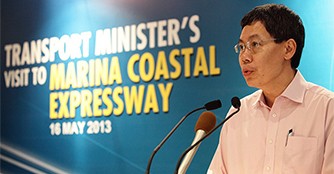Marina Expressway gets underway for opening by year end
17 May 2013|6,937 views

The update came from Transport Minister, Mr Lui Tuck Yew, during a visit to the MCE control centre yesterday.
The five-kilometre expressway costs $4.3 billion to build, and comprises of a 420-metre undersea tunnel. It will connect existing East Coast Parkway (ECP) and Kallang-Paya Lebar Expressway (KPE) to the Ayer Rajah Expressway (AYE).
With five lanes on each direction, the MCE can carry up to 10,000 cars an hour. The aim is to ease congestion on the ECP, and serve as an alternative to link up the various expressways.
The MCE is designed for a speed limit of 80km/h. And as it links directly to the KPE, the Land Transport Authority (LTA) is re-evaluating the speed limit of KPE and whether it should be raised to match the MCE's 80km/h.
A portion of the ECP after Benjamin Sheares Bridge will be converted to arterial road after the MCE is in service. The LTA will also adjust the ERP rates for various gantries along the side roads which link to the MCE.
The MCE has a total of nine entry and exit points, linking to ECP, Marina Boulevard, Central Boulevard and Maxwell Road. If the need arises, five more access points can be established in Marina East.
The Marina Coastal Expressway (MCE) is into its final phase of testing and system commissioning, and will be ready for use at the end of this year.
The update came from Transport Minister, Mr Lui Tuck Yew, during a visit to the MCE control centre yesterday.
The five-kilometre expressway costs $4.3 billion to build, and comprises of a 420-metre undersea tunnel. It will connect existing East Coast Parkway (ECP) and Kallang-Paya Lebar Expressway (KPE) to the Ayer Rajah Expressway (AYE).
With five lanes on each direction, the MCE can carry up to 10,000 cars an hour. The aim is to ease congestion on the ECP, and serve as an alternative to link up the various expressways.
The MCE is designed for a speed limit of 80km/h. And as it links directly to the KPE, the Land Transport Authority (LTA) is re-evaluating the speed limit of KPE and whether it should be raised to match the MCE's 80km/h.
A portion of the ECP after Benjamin Sheares Bridge will be converted to arterial road after the MCE is in service. The LTA will also adjust the ERP rates for various gantries along the side roads which link to the MCE.
The MCE has a total of nine entry and exit points, linking to ECP, Marina Boulevard, Central Boulevard and Maxwell Road. If the need arises, five more access points can be established in Marina East.
The update came from Transport Minister, Mr Lui Tuck Yew, during a visit to the MCE control centre yesterday.
The five-kilometre expressway costs $4.3 billion to build, and comprises of a 420-metre undersea tunnel. It will connect existing East Coast Parkway (ECP) and Kallang-Paya Lebar Expressway (KPE) to the Ayer Rajah Expressway (AYE).
With five lanes on each direction, the MCE can carry up to 10,000 cars an hour. The aim is to ease congestion on the ECP, and serve as an alternative to link up the various expressways.
The MCE is designed for a speed limit of 80km/h. And as it links directly to the KPE, the Land Transport Authority (LTA) is re-evaluating the speed limit of KPE and whether it should be raised to match the MCE's 80km/h.
A portion of the ECP after Benjamin Sheares Bridge will be converted to arterial road after the MCE is in service. The LTA will also adjust the ERP rates for various gantries along the side roads which link to the MCE.
The MCE has a total of nine entry and exit points, linking to ECP, Marina Boulevard, Central Boulevard and Maxwell Road. If the need arises, five more access points can be established in Marina East.
Latest COE Prices
October 2025 | 1st BIDDING
NEXT TENDER: 23 Oct 2025
CAT A$128,105
CAT B$141,000
CAT C$74,301
CAT E$140,009
View Full Results Thank You For Your Subscription.

















